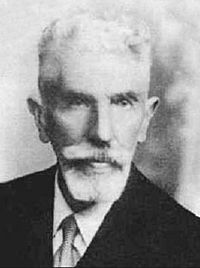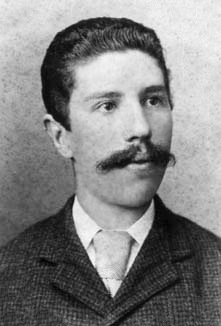Guido Castelnuovo facts for kids
Quick facts for kids
Guido Castelnuovo
|
|
|---|---|
 |
|
| Born | 14 August 1865 |
| Died | 27 April 1952 (aged 86) |
| Nationality | Italian |
| Alma mater | University of Padua |
| Scientific career | |
| Fields | Mathematics |
| Institutions | University of Rome Scuola Normale Superiore di Pisa |
| Doctoral advisor | Giuseppe Veronese |
| Doctoral students | Enrico Bompiani Federigo Enriques Gheorghe Mihoc Oscar Zariski |
Guido Castelnuovo (born August 14, 1865 – died April 27, 1952) was an important Italian mathematician. He is most famous for his work in algebraic geometry, which is a branch of mathematics that uses algebra to study geometric shapes. He also made big contributions to the study of statistics and probability theory.
Contents
A Look at His Life
Early Years and Education
Guido Castelnuovo was born in Venice. His father, Enrico Castelnuovo, was a writer who supported the idea of Italy becoming one united country. Guido went to the University of Padua and graduated in 1886. There, he learned from a great teacher named Giuseppe Veronese. After university, he started working with another mathematician, Corrado Segre, who helped him a lot. This was the start of a long and helpful partnership.
His Career in Mathematics
After graduating, Castelnuovo spent a year in Rome studying advanced geometry. Then, he became an assistant at the University of Turin. He was greatly influenced by Corrado Segre there. In 1891, he moved back to Rome to teach geometry. He worked alongside his former teacher, Luigi Cremona, and later took over his position in 1903.
Castelnuovo also started the University of Rome's School of Statistics and Actuarial Sciences in 1927. This school focused on using mathematics to understand data and risks. He inspired many younger Italian mathematicians and statisticians.
Facing Difficult Times
Castelnuovo stopped teaching in 1935. This was a very hard time in Italy. In 1922, Benito Mussolini came to power. Later, in 1938, new laws were made that were unfair to Jewish people. These laws meant that Castelnuovo, who was Jewish, could not work in public jobs.
During World War II, he had to hide to stay safe. But even then, he bravely organized and taught secret classes for Jewish students. These students were also not allowed to go to university.
Later Life and Legacy
After Rome was freed in June 1944, Castelnuovo was asked to help fix the damage done to Italian science by Mussolini's rule. He became the president of the Accademia dei Lincei, a famous Italian scientific academy, and stayed in that role until he passed away. He was also chosen as a member of the Académie des Sciences in Paris. In 1949, he became a senator for life for the Italian Republic.
Guido Castelnuovo died in Rome on April 27, 1952, at the age of 86. He is buried with his wife and his daughter, Emma Castelnuovo, who was also a mathematician.
His Important Work
Studying Curves and Surfaces
In Turin, Castelnuovo focused on algebraic curves, which are shapes described by algebraic equations. He also helped to better understand the work of other mathematicians like Alexander von Brill and Max Noether.
Castelnuovo had his own ideas about how to teach mathematics. He believed in giving students a general overview first, and then diving deep into a specific area like algebraic curves. He explained that this way, students would have both a broad understanding and deep knowledge of one field.
Exploring New Ideas
He also taught about algebraic functions and abelian integrals. In these classes, he covered topics like Riemann surfaces (complex shapes), non-Euclidean geometry (different types of geometry), differential geometry (studying shapes using calculus), and probability theory. He found probability theory especially interesting because it was a newer field that clearly showed how math could be used to understand real-world events.
In 1919, he wrote an early textbook on probability called Calcolo della probabilità e applicazioni. He also wrote a book about calculus called Le origini del calcolo infinitesimale nell'era moderna.
Key Contributions to Geometry
Castelnuovo's most important work was in algebraic geometry. In the early 1890s, he published three famous papers. One of these papers was the first to use a special concept called the "characteristic linear series of a family of curves." The Castelnuovo–Severi inequality is partly named after him.
He worked closely with Federigo Enriques on the theory of surfaces, which are 2D shapes in 3D space. Their teamwork started in 1892 and lasted for over 20 years. They even submitted their work together for a big math prize, but didn't win that time because they sent it as a team instead of individually. They both won the prize in later years.
Another important idea named after Castelnuovo is the Kronecker–Castelnuovo theorem (1894). This theorem helps mathematicians understand certain types of algebraic surfaces. In total, Castelnuovo wrote over 100 articles, books, and reports on mathematics.
See also
 In Spanish: Guido Castelnuovo para niños
In Spanish: Guido Castelnuovo para niños
- Castelnuovo curve
- Castelnuovo–Mumford regularity
- Castelnuovo theorem
- Castelnuovo surface
- Castelnuovo–de Franchis theorem
- Castelnuovo–Richmond–Igusa quartic
- Noether–Castelnouvo theorem
- Homogeneous coordinate ring
- Riemann–Roch theorem for surfaces
- Italian school of algebraic geometry


